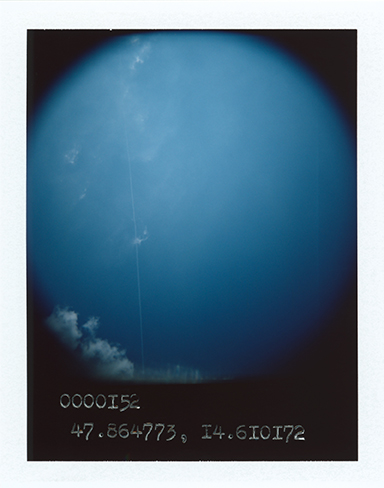The Blue Skies Project
One thousand and seventy-eight photographs of the sky above the last known location of every former Nazi Germany concentration camp will go on display at the Fitzrovia Chapel in May. The Blue Skies Project by Belgian artist, Anton Kusters, will be accompanied by an audio work by Ruben Samama, tracking 13-years in real time from the date of the opening of the first concentration camp in Nazi Germany to the closing of the last. This is the first time that this immersive, multi-media installation has gone on display in the capital and will coincide with Photo London.
The Blue Skies Journey
In 2012, Kusters set out to photograph the sites of the official concentration camps which existed throughout Europe between 1933 and 1945. Over the course of five years he photographed the sky above the co-ordinates of each site, using precisely the same camera settings and often waiting for days for a clear sky. The resulting images of blue skies collectively bear witness to the systematic trauma which happened below.
Each photograph is blind-stamped with an identification number and the GPS co-ordinates of the site, along with the estimated number deaths for each location. This stark data, reducing the sites and victims to numbers, is a chilling reference to the systematic efficiency of the Nazi’s programme of extermination. The simplicity of this project, void of landscapes, streets, objects, interiors, signs, scars or traces of humanity, presented alongside Samama’s installation, creates an immersive experience, encouraging contemplation.
“Sometimes, as in Kusters’ Blue Skies, the equation becomes more complex, fraught by a tangle of historical, aesthetic, moral and personal questions. The event that he set out to explore and capture is already a fading memory. The places, even if they can be accurately located, refuse to be contained, and cannot be encompassed by a single point of view. The artist has chosen to witness at the spot the event’s vanishing and most intangible residue in the form of reflected light.”
– Martin Barnes, Senior Curator, Photographs, Victoria & Albert Museum, London
The Blue Skies background
The Blue Skies Project was initiated following the death of Kusters’ grandfather and a mysterious story concerning his time during World War II. Neither Jewish, nor a member of the Belgian resistance, Kusters’ grandfather was nevertheless targeted for deportation by the SS in 1943, and they came looking specifically for him in his small Belgian village. He was able to flee the night they raided his house and avoided capture. Kusters was not able to ask his grandfather about the details before his death and so a link between an unresolved past and a trail of speculation was established. If his grandfather had been captured, where might he have been taken? What would he have witnessed and remembered?
The artist
Anton Kusters was born in Belgium (1974), and obtained a master’s degree in Political Science at K.U.Leuven. He studied photography at STUK Leuven and Academy of Fine Arts, Hasselt. His major works are the Yakuza (2011), Mono No Aware (2014) and the online epistolary #image_by_image, an experimental public dialogue based on associations of image and word, fragment and concept, re-contextualisation and reflection. In 2019, he was nominated for the Prix Pictet.
He is the co-founder of BURN Magazine, an award-winning online platform dedicated to emerging photographers. The Blue Skies Project is produced and curated by longstanding collaborator Monica Allende (UK). It will also be on display at the US Holocaust Memorial Museum in Washington DC from late April 2019 and a book of the project published in 2020.
Exhibition details
The Blue Skies Project by Anton Kusters
The Fitzrovia Chapel, Fitzroy Place, 2 Pearson Square, London, W1T
15 – 19 May 2019, 11.00 – 18.00


